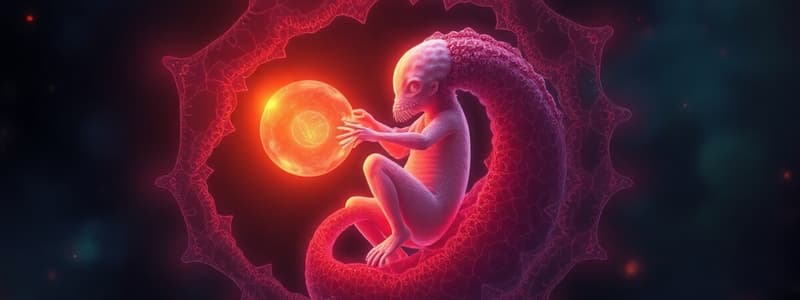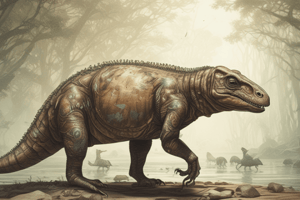Podcast
Questions and Answers
What characteristic defines amniotes?
What characteristic defines amniotes?
- Ability to breathe underwater
- Development of an amniotic egg (correct)
- Possession of limbs
- Presence of gills in adulthood
What is one of the forms of membranes that protect amniote embryos?
What is one of the forms of membranes that protect amniote embryos?
- Ectoderm
- Mesoderm
- Chorion (correct)
- Endoderm
Which feature of amniote eggs helps with respiration and waste disposal?
Which feature of amniote eggs helps with respiration and waste disposal?
- Amnion
- Allantois (correct)
- Chalaza
- Vitelline membrane
What evolutionary advantage did the first amniotes possess?
What evolutionary advantage did the first amniotes possess?
Which of these amniote features is specifically for surviving in dry environments?
Which of these amniote features is specifically for surviving in dry environments?
What did the evolution of amniote eggs enable in terms of reproductive strategy?
What did the evolution of amniote eggs enable in terms of reproductive strategy?
Which stage of development is typically absent in amniotes compared to amphibians?
Which stage of development is typically absent in amniotes compared to amphibians?
What type of egg did the first amniotes like Casineria kiddi possess?
What type of egg did the first amniotes like Casineria kiddi possess?
What is a primary advantage of the upright walking stance seen in most dinosaurs compared to modern reptiles?
What is a primary advantage of the upright walking stance seen in most dinosaurs compared to modern reptiles?
Which type of organ is Jacobson's organ in reptiles associated with?
Which type of organ is Jacobson's organ in reptiles associated with?
Which pelvic structure corresponds to the 'lizard hipped' classification of dinosaurs?
Which pelvic structure corresponds to the 'lizard hipped' classification of dinosaurs?
What characteristic distinguishes ornithischian dinosaurs from other groups?
What characteristic distinguishes ornithischian dinosaurs from other groups?
Who first used the term 'dinosaur' and in what year?
Who first used the term 'dinosaur' and in what year?
What is a key distinction between reptiles and amphibians in terms of the nervous system?
What is a key distinction between reptiles and amphibians in terms of the nervous system?
Which group of animals are classified as archosaurs along with dinosaurs?
Which group of animals are classified as archosaurs along with dinosaurs?
In what period did the classification of dinosaurs into groups based on pelvic girdle structures begin?
In what period did the classification of dinosaurs into groups based on pelvic girdle structures begin?
What adaptations allowed amniotes to lay larger eggs in drier habitats?
What adaptations allowed amniotes to lay larger eggs in drier habitats?
Which characteristic differentiates the three main lines of amniotes?
Which characteristic differentiates the three main lines of amniotes?
What was a significant change in diet for amniotes as they increased in body size?
What was a significant change in diet for amniotes as they increased in body size?
What group is considered the sole survivor of the lineage that existed 100 million years ago?
What group is considered the sole survivor of the lineage that existed 100 million years ago?
Which time period did amniotes likely arise from amphibian-like tetrapods?
Which time period did amniotes likely arise from amphibian-like tetrapods?
Which statement is true regarding the age of reptiles?
Which statement is true regarding the age of reptiles?
What type of evolutionary trends complicate the understanding of reptile history?
What type of evolutionary trends complicate the understanding of reptile history?
What is a characteristic feature of anapsids?
What is a characteristic feature of anapsids?
What is the estimated weight range of Herrerasaurus?
What is the estimated weight range of Herrerasaurus?
Which of the following characteristics is associated with Herrerasaurus?
Which of the following characteristics is associated with Herrerasaurus?
What type of diet did Herrerasaurus primarily have?
What type of diet did Herrerasaurus primarily have?
Which of the following prey is likely to have been consumed by Herrerasaurus?
Which of the following prey is likely to have been consumed by Herrerasaurus?
Which feature of Herrerasaurus suggests it was a swift runner?
Which feature of Herrerasaurus suggests it was a swift runner?
In what type of environment did Herrerasaurus live?
In what type of environment did Herrerasaurus live?
What anatomical feature of Herrerasaurus indicates its predatory nature?
What anatomical feature of Herrerasaurus indicates its predatory nature?
What evidence suggests that Herrerasaurus could digest bones?
What evidence suggests that Herrerasaurus could digest bones?
What type of environment did Spinosaurus inhabit?
What type of environment did Spinosaurus inhabit?
What is a key feature of Spinosaurus that suggests its adaptation for a specific predatory lifestyle?
What is a key feature of Spinosaurus that suggests its adaptation for a specific predatory lifestyle?
How does Spinosaurus' sail potentially function in its environment?
How does Spinosaurus' sail potentially function in its environment?
Which of the following is a hypothesis about the purpose of the sail in Spinosaurus?
Which of the following is a hypothesis about the purpose of the sail in Spinosaurus?
What does the discovery of a tooth embedded in a South American pterosaur bone suggest about Spinosaurus?
What does the discovery of a tooth embedded in a South American pterosaur bone suggest about Spinosaurus?
What is not a primary function attributed to the sail of Spinosaurus?
What is not a primary function attributed to the sail of Spinosaurus?
What aspect of the sail of Spinosaurus is similar to that of Dimetrodon?
What aspect of the sail of Spinosaurus is similar to that of Dimetrodon?
Why might large animals like Spinosaurus face challenges in regulating body temperature?
Why might large animals like Spinosaurus face challenges in regulating body temperature?
Flashcards are hidden until you start studying
Study Notes
Amniotes Overview
- Amniotes are tetrapod vertebrates including reptiles, birds, and mammals characterized by the presence of an amniotic egg.
- They evolved approximately 340 million years ago, distinguishing themselves by their eggs' ability to survive on land, breathe, and manage waste.
Embryonic Development
- Amniote embryos are supported by specialized membranes: amnion, chorion, and allantois.
- Unlike amphibians, amniotes develop directly into terrestrial forms instead of undergoing a larval stage.
Egg Features
- Amniote eggs feature a structure including eggshell, inner and outer membranes, chalaza, various types of albumen, and yolk.
- Eggs have sturdy, porous shells for protection and can manage gas exchange and waste disposal.
Evolutionary Traits
- Initial amniotes had soft-shelled, small eggs and required internal fertilization due to environmental challenges on land.
- The evolution of a tougher eggshell allowed for larger egg sizes and survival in drier habitats.
Amniote Lineages
- Three main lines of amniotes: anapsids (turtles with no temporal fenestrae), synapsids (mammals with one temporal fenestra), and diapsids (most reptiles and birds with two fenestrae).
Reptilia Class Characteristics
- Reptilia, the first fully terrestrial vertebrates, include nearly 8000 species across diverse habitats.
- Dinosaurs ruled for over 165 million years and exhibited remarkable size variations.
Origin of Reptiles
- Amniotes originated from amphibian-like tetrapods (anthracosaurs) during the early Carboniferous period.
- Modern reptiles often walk with splayed legs, while dinosaurs and some lizards have an upright limb posture for efficient movement.
Reptilian Nervous Systems
- Reptilian brains possess complex neural networks with a relatively large cerebrum, enhancing behavioral capabilities compared to amphibians.
- Sense organs, especially olfactory capabilities via Jacobson's organ, are well developed in reptiles.
Dinosaur Classification
- The term "dinosaur" was coined in 1841 to describe large fossil reptiles. By 1887, dinosaurs were categorized into Saurischia (lizard-hipped) and Ornithischia (bird-hipped) groups based on hip structures.
- Birds are descendants of the Saurischia lineage.
Herrerasaurus Information
- Considered one of the first dinosaurs, Herrerasaurus was a bipedal carnivore, measuring between 3m to 6m in length and weighing 210kg to 350kg.
- Adaptations suggest it was a swift runner with a strong tail and specialized teeth for a carnivorous diet.
Spinosaurus Characteristics
- Spinosaurus inhabited northern Africa, possibly navigating tidal flats; it had elongated jaws and conical teeth suited for diverse feeding habits.
- The sail of Spinosaurus may have functioned in thermoregulation, courtship displays, or intimidation.
Environmental Context
- Spinosaurus coexisted with large predators, showcasing a complex ecosystem comprising various herbivores prevalent during its era.
- Fossils indicate a volcanically active floodplain with diverse vegetation, influencing dietary patterns of carnivorous and herbivorous species.
Studying That Suits You
Use AI to generate personalized quizzes and flashcards to suit your learning preferences.




